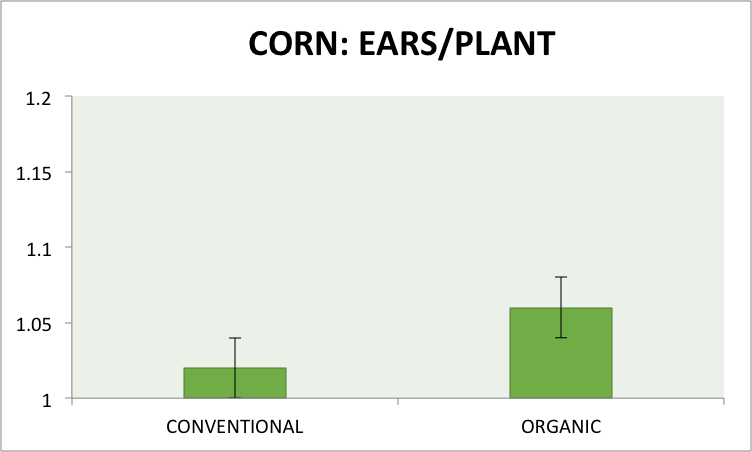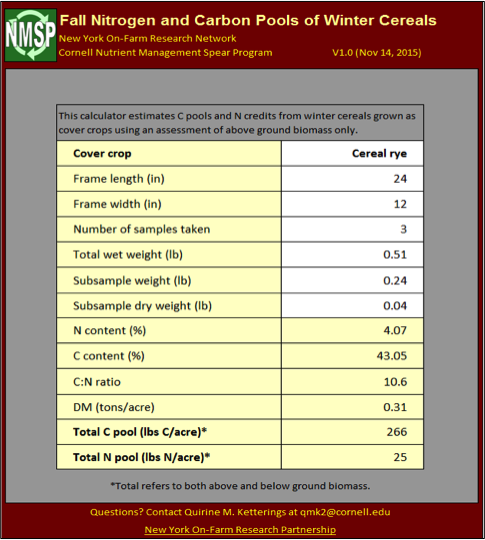Bill Cox1 and Eric Sandsted1
1Soil and Crop Sciences Section – School of Integrated Plant Science, Cornell University
We initiated a 3-year study at the Aurora Research Farm in 2015 to compare the corn, soybean, and wheat/red clover rotation under conventional and organic cropping systems during the 3-year transition period (2015-2017) to an organic cropping system. We used three entry points or previous crops from 2014 to initiate the 2015-2017 study: 1) grain corn, 2) small grain, and 3) soybean. Three of the many objectives of the study are 1) to determine the best previous crop (2014) for the transition, 2) the best crop to plant in the first year (2015) during the transition and 3) do corn, soybean, and wheat respond similarly to management inputs (high and recommended) under conventional and organic cropping systems? We reported in a previous article corn management inputs (hybrid selection, planting date, seeding and N rates, and weed control) under both cropping systems (https://blogs.cornell.edu/whatscroppingup/2015/11/09/corn-yield-under-conventional-and-organic-cropping-systems-with-recommended-and-high-inputs-during-the-transition-year-to-organic/). Likewise, we reported in the same article that corn yielded ~30% lower in the organic compared with the conventional cropping system. Furthermore, management inputs did not impact corn yields under either cropping system. This article will examine the yield component responses of conventional and organic corn averaged across the three previous crops and both management treatments to partially explain why organic corn yielded so much lower in 2015.
Corn populations, averaged across the three previous crops, were lower at the V9 stage between the organic (~25,000 plants/acre in the recommended and ~31,450 plants/acre in the high input treatments) compared with the conventional cropping system (~28,500 plants/acre in recommended and ~34,265 in high input treatments) when counting all the plants in the two harvest rows (https://blogs.cornell.edu/whatscroppingup/2015/07/23/emergence-early-v4-stage-and-final-plant-populations-v10-psnt-values-v4-and-weed-densities-v12-in-corn-under-conventional-and-organic-cropping-systems/). We subsampled two 1 meter lengths of the two harvest rows (hand-harvested all the plants, pulled off the ears and dried them, shelled the ears, counted the kernels, and weighed all the kernels-~6000-7000/sample or 12000-14000 kernels/sub-sampled area) in two regions of our 100 foot plots about a week before harvest. When averaged across the three previous crops and two management systems, plant populations in the sub-sampled areas averaged 7.95 plants/m2 (~31,380 plants/acre) in conventional corn compared with 7.02 plants/m2 (~28,225 plants/acre) in organic corn (Fig.1). The sub-sampled populations averaged only 3% higher in conventional corn and 2% higher in organic corn compared with populations in the entire plot indicating that the sub-sampled areas were very representative of the entire plot area.

When averaged across the three previous crops and two management treatments, conventional corn averaged 1.02 and organic corn averaged 1.06 ears/plant (Fig.2). Typically, hybrids, even modern hybrids, will produce a second ear under low plant populations, although 7.02 plants/m2 is not an exceedingly low final stand. Surprisingly, conventional corn averaged 557 kernels/ear and organic corn only 474 kernels/ear (Fig.3). Corn typically produces more kernels/ear at lower compared with higher final stands because of less intra-plant competition for light, water, and nutrients. Given that the genetics of the hybrids were similar (P9675 and P9675AMXT), except for the GMO traits, in both cropping systems, organic compared with conventional corn should have had greater kernels/ear. Undoubtedly, the lower kernel number per ear as well as the lower final plant populations were major factors in lower organic compared with conventional corn yields.


When averaged across the previous crops, seed mass averaged 254 mg in conventional corn but only 240 mg in organic corn (Fig.4). Typically, corn at higher final stands has lower seed mass (weight of an individual kernel) than corn at lower final stands again because of greater intra-plant completion. (Corn with fewer kernels/ear also typically has greater seed weight). So the lack of yield component compensation by organic corn (no increased kernel number and kernel weight in the presence of lower final stands) appears to be the major factor in lower organic corn yields.

If you multiply out the yield components (plants/m2 x ears/plant x kernels/ear x kernel weight), the sub-sample yields averaged 182 bushels/acre in corn compared with 134 bushels/acre in organic corn. Although the sub-sample yields were ~10% greater than the actual plot yield in conventional corn (165 bushels/acre along the 100 foot long plot yield) and ~18% higher in organic corn (113 bushels/acre for the plot yield), we believe that the sub-sample yield component data provide a valid explanation for the lower organic corn yields. In fact, organic vs. conventional corn in the sub-sampled area yielded 26.5% lower compared with 31.5% for the plot yield, which is fairly similar.
Why the lack of yield component compensation for the organic corn in 2015? We presented weed count data in a previous article that showed organic corn averaged ~2.25 weeds/m2 compared with 0.4 weeds/m2 in conventional corn at the V12 stage (https://blogs.cornell.edu/whatscroppingup/2015/07/23/emergence-early-v4-stage-and-final-plant-populations-v10-psnt-values-v4-and-weed-densities-v12-in-corn-under-conventional-and-organic-cropping-systems/). Certainly, severe weed pressure could reduce kernel number and kernel weight, especially if weed densities are high early in the growing season. However, visual observations revealed that 95% of the organic corn plot was weed-free and the higher weed densities were mostly because of clumps of weeds in small sections along the plot length. So higher weed counts may have contributed slightly to the lower kernel number and kernel weight in organic corn but we do not believe that it was the major factor.
Instead, visual observations indicated N deficiency in organic corn throughout the season and stalk nitrate and grain N data confirm those observations (Fig.5 and 6). Stalk nitrate concentrations of conventional corn, which averaged ~450 ppm, indicated only marginal N status for maximum yield probably because of dry soil conditions during the grain-filling period (only 2.75 inches of precipitation from silking through black-layer formation). Organic corn had stalk concentrations of only ~50 ppm, which indicates severe N deficiency. Some have questioned the accuracy of the stalk nitrate test, as it relates to organic corn, and the exceedingly low values of 50 ppm reinforce that concept. Grain N concentrations, however, also indicate lower N in organic corn (1.18%) compared with conventional corn (1.44%). Given, the visual symptoms of N deficiency of organic corn during the growing season, coupled with the extremely low stalk nitrate and the lower grain N concentrations, we believe that N availability was probably the major factor in the lower organic corn yields.


Apparently, the composted chicken manure applied pre-plant to organic corn the day before planting (May 23) either denitrified because of extreme wet June conditions (8.00 inches of rain) or just did not mineralize enough to meet the N demand of corn (the majority of N fertilizer to conventional corn was side-dressed in late June so did not experience this problem). This would result in N deficiency in the 2 week period before and after silking (~July 15-August 10), the growth period when final kernel number in corn is determined. Likewise, a lack of N from 2 weeks after silking to a week before black layer formation (~August 10-September 10) would result in lower kernel weight. So low N availability probably contributed the most to lack of yield component compensation of organic corn (15% fewer kernels/ear and 5.5% lower seed weight for organic corn), in the presence of lower final stands (~12% fewer plants/m2), which contributed to 31.5% lower yields for organic compared with conventional corn.
In defense of organic corn, we did not know about funding for this research until mid-April of 2015 so the typical green manure crop or animal manure was not used on organic corn. Consequently, organic corn was not given the best N management practices during the first transition year. If corn is selected as the first year transition crop, a small grain crop with a red clover inter-seeding or a field with recent animal manure applications would be the best management strategy. The green manure crop or animal manure would provide the majority of the N requirement of organic corn and composted chicken manure could be used as a supplemental N source. Fortunately, we have a robust red clover crop in place so we expect organic corn to perform much better relative to conventional corn in 2016.









